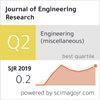Development and biomechanical testing of full-scale human brain simulant
IF 0.9
4区 工程技术
Q3 ENGINEERING, MULTIDISCIPLINARY
引用次数: 0
Abstract
In 21st century, traumatic Brain Injuries (TBI) due to blast exposure or head impacts in contact sports, accidents are one of most critical research area. But the area of TBI is poorly investigated due to the limitation of brain tissue availability and related ethical/biosafety issues. In general, the brain tissue is difficult to acquire after the autopsy and test in laboratorial settings. In this work, a full-size human brain simulant was developed using a biofidelic multi-part polymeric material poured into a negative mould which was designed and 3D printed. Based on the number of mild to moderate traumatic brain injury cases reported in the literature, three TBI prominent locations were chosen. The prefrontal cortex of frontal lobe, top portion of parietal lobe and temporal lobe of right hemisphere of the brain were the locations where the experiments were conducted under compressive loading conditions. The load versus displacement data was recorded and converted to the stress-strain plots to analyse the result responses and its implications. Two constitutive hyperelastic models (Yeoh model and Neo-Hookean) were selected for curve fitting and characterizing the non-linear mechanical behavior of the full-scale brain model. Such precisely developed and characterized full-scale brain simulant has not been reported in the literature to date and would be beneficial for simulating a wide range of traumatic brain injuries and surgical training.
全尺寸人脑模拟器的开发与生物力学测试
在21世纪,接触性运动中由于爆炸暴露或头部撞击而引起的创伤性脑损伤(TBI)是研究的热点之一。但由于脑组织可用性的限制以及相关的伦理/生物安全问题,对TBI领域的研究很少。一般来说,在尸检和实验室测试后很难获得脑组织。在这项工作中,一个全尺寸的人脑模拟物被开发出来,使用一种多部分的生物聚合物材料倒进一个设计和3D打印的负模中。根据文献报道的轻至中度创伤性脑损伤病例的数量,选择三个TBI突出部位。在压缩加载条件下,实验以大脑额叶前额皮质、顶叶顶部和右半球颞叶为实验部位。记录荷载与位移的数据,并将其转换为应力-应变图,以分析结果响应及其含义。选取两种本构超弹性模型(Yeoh模型和Neo-Hookean模型)进行曲线拟合,表征全尺寸脑模型的非线性力学行为。这种精确开发和表征的全尺寸脑模拟物迄今尚未在文献中报道,它将有利于模拟大范围的创伤性脑损伤和外科训练。
本文章由计算机程序翻译,如有差异,请以英文原文为准。
求助全文
约1分钟内获得全文
求助全文
来源期刊

Journal of Engineering Research
ENGINEERING, MULTIDISCIPLINARY-
CiteScore
1.60
自引率
10.00%
发文量
181
审稿时长
20 weeks
期刊介绍:
Journal of Engineering Research (JER) is a international, peer reviewed journal which publishes full length original research papers, reviews, case studies related to all areas of Engineering such as: Civil, Mechanical, Industrial, Electrical, Computer, Chemical, Petroleum, Aerospace, Architectural, Biomedical, Coastal, Environmental, Marine & Ocean, Metallurgical & Materials, software, Surveying, Systems and Manufacturing Engineering. In particular, JER focuses on innovative approaches and methods that contribute to solving the environmental and manufacturing problems, which exist primarily in the Arabian Gulf region and the Middle East countries. Kuwait University used to publish the Journal "Kuwait Journal of Science and Engineering" (ISSN: 1024-8684), which included Science and Engineering articles since 1974. In 2011 the decision was taken to split KJSE into two independent Journals - "Journal of Engineering Research "(JER) and "Kuwait Journal of Science" (KJS).
 求助内容:
求助内容: 应助结果提醒方式:
应助结果提醒方式:


